英语语法-therebe结构用法
- 格式:doc
- 大小:79.00 KB
- 文档页数:36
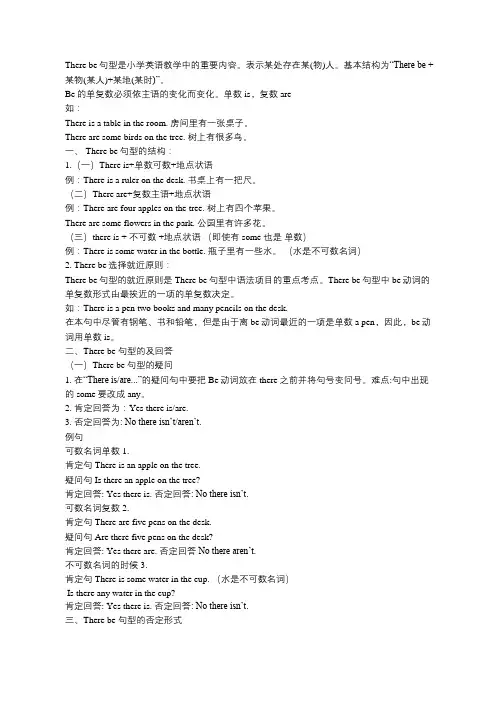
There be句型是小学英语教学中的重要内容。
表示某处存在某(物)人。
基本结构为“There be +某物(某人)+某地(某时)”。
Be的单复数必须依主语的变化而变化。
单数is,复数are如:There is a table in the room. 房间里有一张桌子。
There are some birds on the tree. 树上有很多鸟。
一、 There be句型的结构:1.(一)There is+单数可数+地点状语例:There is a ruler on the desk. 书桌上有一把尺。
(二)There are+复数主语+地点状语例:There are four apples on the tree. 树上有四个苹果。
There are some flowers in the park. 公园里有许多花。
(三)there is + 不可数 +地点状语(即使有some 也是单数)例:There is some water in the bottle. 瓶子里有一些水。
(水是不可数名词)2. There be选择就近原则:There be句型的就近原则是There be句型中语法项目的重点考点。
There be句型中be动词的单复数形式由最挨近的一项的单复数决定。
如:There is a pen two books and many pencils on the desk.在本句中尽管有钢笔、书和铅笔,但是由于离be动词最近的一项是单数a pen,因此,be动词用单数is。
二、There be 句型的及回答(一)There be 句型的疑问1. 在“There is/are...”的疑问句中要把Be动词放在there之前并将句号变问号。
难点:句中出现的some要改成any。
2. 肯定回答为:Yes there is/are.3. 否定回答为: No there isn’t/aren’t.例句可数名词单数 1.肯定句There is an apple on the tree.疑问句 Is there an apple on the tree?肯定回答: Yes there is. 否定回答: No there isn’t.可数名词复数2.肯定句There are five pens on the desk.疑问句Are there five pens on the desk?肯定回答: Yes there are. 否定回答No there aren’t.不可数名词的时候 3.肯定句 There is some water in the cup. (水是不可数名词)Is there any water in the cup?肯定回答: Yes there is. 否定回答: No there isn’t.三、There be 句型的否定形式(一)There be 句型的否定:否定形式只要在be动词后面加not即可,is not =isn’t are not= aren’t但要注意的是句中如果出现some则改成any.1.There is a knife in the kitchen. 否定:There is not a knife in the kitchen.2.There are five apples on the tree. 否定:There are not five apples on the tree.3.There is some ink in the bottle. 否定:There is not any ink in the bottle. (ink是墨水,不可数名词)4.There are some birds singing in the tree. 否定:There are not any birds singing in the tree.相关推荐1.a (an) art. 一个2.afternoon n. 下午3.and conj. 和4.apple n. 苹果5.arm n. 胳膊,手臂6.autumn n. 秋天7. bag n. 书包8.basketball n. 篮球9.be(am/is/are) v. (be动词)是 10.be...There be句型是小学英语教学中的重要内容。
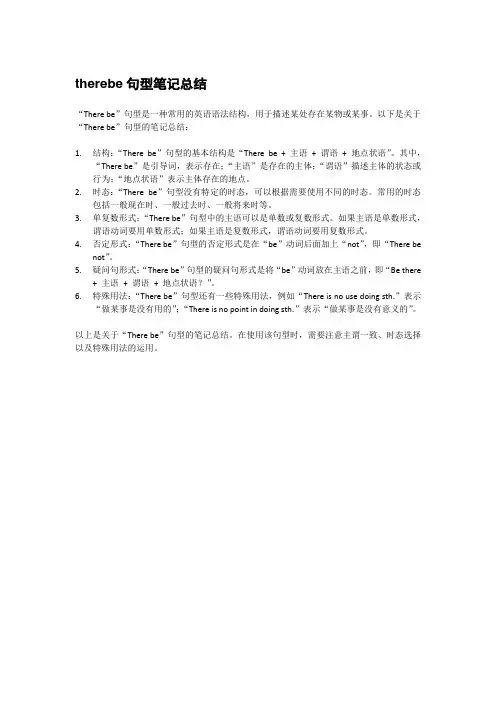
therebe句型笔记总结
“There be”句型是一种常用的英语语法结构,用于描述某处存在某物或某事。
以下是关于“There be”句型的笔记总结:
1.结构:“There be”句型的基本结构是“There be + 主语+ 谓语+ 地点状语”。
其中,
“There be”是引导词,表示存在;“主语”是存在的主体;“谓语”描述主体的状态或行为;“地点状语”表示主体存在的地点。
2.时态:“There be”句型没有特定的时态,可以根据需要使用不同的时态。
常用的时态
包括一般现在时、一般过去时、一般将来时等。
3.单复数形式:“There be”句型中的主语可以是单数或复数形式。
如果主语是单数形式,
谓语动词要用单数形式;如果主语是复数形式,谓语动词要用复数形式。
4.否定形式:“There be”句型的否定形式是在“be”动词后面加上“not”,即“There be
not”。
5.疑问句形式:“There be”句型的疑问句形式是将“be”动词放在主语之前,即“Be there
+ 主语+ 谓语+ 地点状语?”。
6.特殊用法:“There be”句型还有一些特殊用法,例如“There is no use doing sth.”表示
“做某事是没有用的”;“There is no point in doing sth.”表示“做某事是没有意义的”。
以上是关于“There be”句型的笔记总结。
在使用该句型时,需要注意主谓一致、时态选择以及特殊用法的运用。
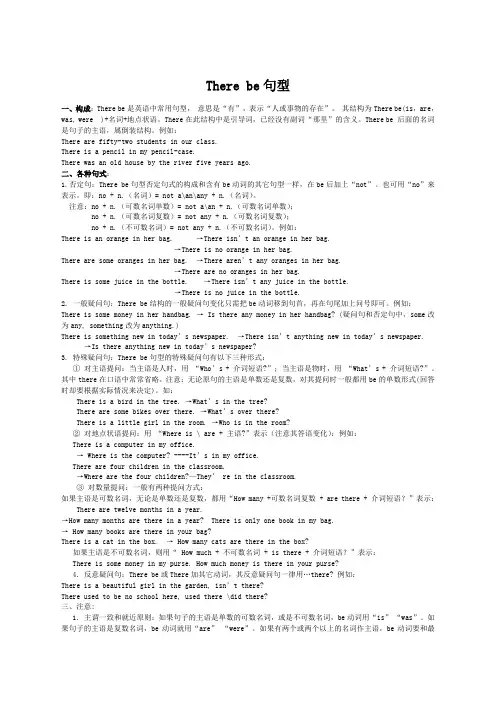
There be句型一、构成:There be是英语中常用句型,意思是“有”,表示“人或事物的存在”。
其结构为There be(is,are,was, were )+名词+地点状语。
There在此结构中是引导词,已经没有副词“那里”的含义。
There be 后面的名词是句子的主语,属倒装结构。
例如:There are fifty-two students in our class.There is a pencil in my pencil-case.There was an old house by the river five years ago.二、各种句式:1.否定句:There be句型否定句式的构成和含有be动词的其它句型一样,在be后加上“not”。
也可用“no”来表示。
即:no + n.(名词)= not a\an\any + n.(名词)。
注意:no + n.(可数名词单数)= not a\an + n.(可数名词单数);no + n.(可数名词复数)= not any + n.(可数名词复数);no + n.(不可数名词)= not any + n.(不可数名词)。
例如:There is an orange in her bag. →There isn’t an orange in her bag.→There is no orange in her bag.There are some oranges in her bag. →There aren’t any oranges in her bag.→There are no oranges in her bag.There is some juice in the bottle. →There isn’t any juice in the bottle.→There is no juice in the bottle.2. 一般疑问句:There be结构的一般疑问句变化只需把be动词移到句首,再在句尾加上问号即可。
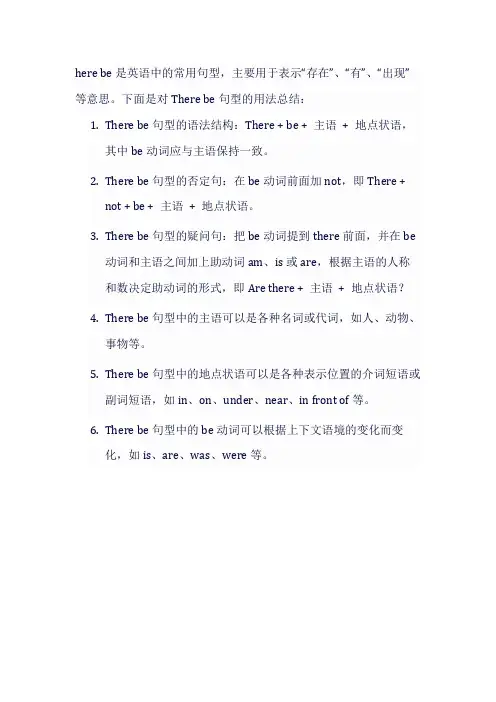
here be是英语中的常用句型,主要用于表示“存在”、“有”、“出现”等意思。
下面是对There be句型的用法总结:
1.There be句型的语法结构:There + be + 主语+ 地点状语,
其中be动词应与主语保持一致。
2.There be句型的否定句:在be动词前面加not,即There +
not + be + 主语+ 地点状语。
3.There be句型的疑问句:把be动词提到there前面,并在be
动词和主语之间加上助动词am、is或are,根据主语的人称
和数决定助动词的形式,即Are there + 主语+ 地点状语?
4.There be句型中的主语可以是各种名词或代词,如人、动物、
事物等。
5.There be句型中的地点状语可以是各种表示位置的介词短语或
副词短语,如in、on、under、near、in front of等。
6.There be句型中的be动词可以根据上下文语境的变化而变
化,如is、are、was、were等。
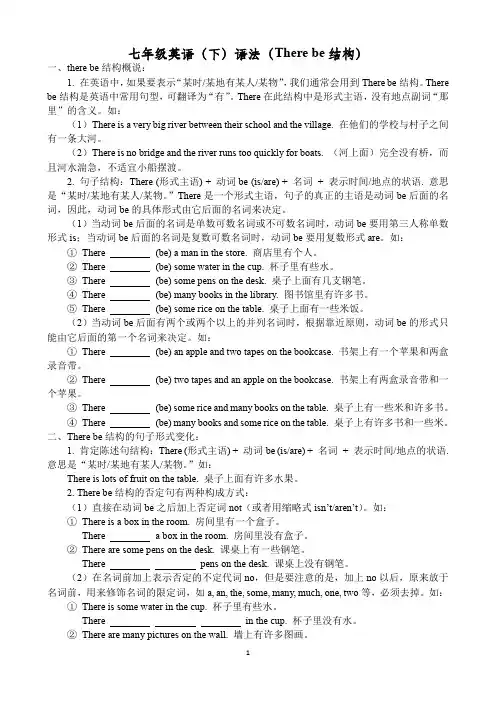
七年级英语(下)语法(There be结构)一、there be结构概说:1. 在英语中,如果要表示“某时/某地有某人/某物”,我们通常会用到There be结构。
There be结构是英语中常用句型,可翻译为“有”。
There在此结构中是形式主语,没有地点副词“那里”的含义。
如:(1)There is a very big river between their school and the village. 在他们的学校与村子之间有一条大河。
(2)There is no bridge and the river runs too quickly for boats. (河上面)完全没有桥,而且河水湍急,不适宜小船摆渡。
2. 句子结构:There (形式主语) + 动词be (is/are) + 名词+ 表示时间/地点的状语. 意思是“某时/某地有某人/某物。
”There是一个形式主语,句子的真正的主语是动词be后面的名词,因此,动词be的具体形式由它后面的名词来决定。
(1)当动词be后面的名词是单数可数名词或不可数名词时,动词be要用第三人称单数形式is;当动词be后面的名词是复数可数名词时,动词be要用复数形式are。
如:①There (be) a man in the store. 商店里有个人。
②There (be) some water in the cup. 杯子里有些水。
③There (be) some pens on the desk. 桌子上面有几支钢笔。
④There (be) many books in the library. 图书馆里有许多书。
⑤There (be) some rice on the table. 桌子上面有一些米饭。
(2)当动词be后面有两个或两个以上的并列名词时,根据靠近原则,动词be的形式只能由它后面的第一个名词来决定。
如:①There (be) an apple and two tapes on the bookcase. 书架上有一个苹果和两盒录音带。
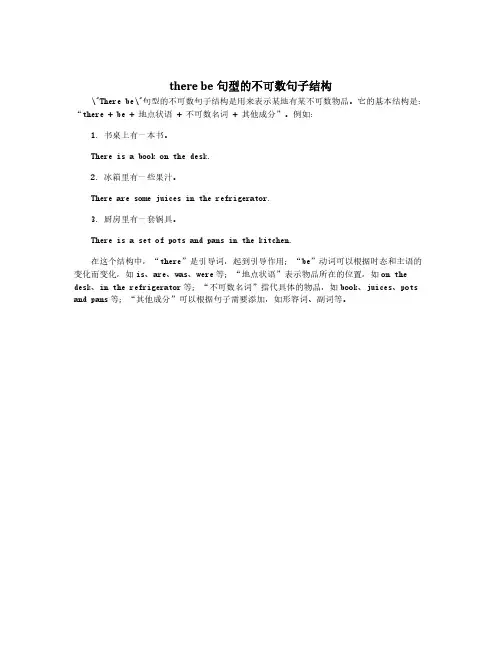
there be句型的不可数句子结构
\"There be\"句型的不可数句子结构是用来表示某地有某不可数物品。
它的基本结构是:“there+be+地点状语+不可数名词+其他成分”。
例如:
1.书桌上有一本书。
There is a book on the desk.
2.冰箱里有一些果汁。
There are some juices in the refrigerator.
3.厨房里有一套锅具。
There is a set of pots and pans in the kitchen.
在这个结构中,“there”是引导词,起到引导作用;“be”动词可以根据时态和主语的变化而变化,如is、are、was、were等;“地点状语”表示物品所在的位置,如on the desk、in the refrigerator等;“不可数名词”指代具体的物品,如book、juices、pots and pans等;“其他成分”可以根据句子需要添加,如形容词、副词等。
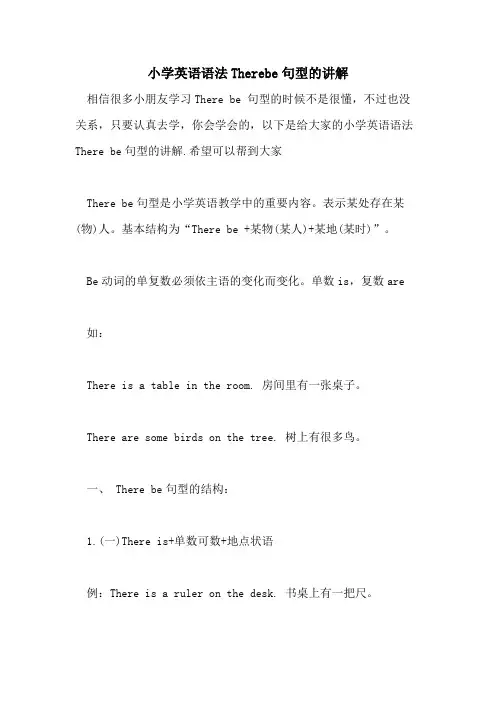
小学英语语法Therebe句型的讲解相信很多小朋友学习There be 句型的时候不是很懂,不过也没关系,只要认真去学,你会学会的,以下是给大家的小学英语语法There be句型的讲解.希望可以帮到大家There be句型是小学英语教学中的重要内容。
表示某处存在某(物)人。
基本结构为“There be +某物(某人)+某地(某时)”。
Be动词的单复数必须依主语的变化而变化。
单数is,复数are如:There is a table in the room. 房间里有一张桌子。
There are some birds on the tree. 树上有很多鸟。
一、 There be句型的结构:1.(一)There is+单数可数+地点状语例:There is a ruler on the desk. 书桌上有一把尺。
(二)There are+复数主语+地点状语例:There are four apples on the tree. 树上有四个苹果。
There are some flowers in the park. 公园里有许多花。
(三)there is + 不可数名词 +地点状语 (即使有some 也是单数)例:There is some water in the bottle. 瓶子里有一些水。
(水是不可数名词)2. There be选择就近原则:There be句型的就近原则是There be句型中语法项目的重点考点。
There be句型中be动词的单复数形式由最挨近的一项的单复数决定。
如:There is a pen, two books and many pencils on the desk.在本句中尽管有钢笔、书和铅笔,但是由于离be动词最近的一项是单数a pen,因此,be动词用单数is。
二、There be 句型的疑问句及回答(一)There be 句型的疑问1. 在“There is/are...”的疑问句中,要把Be动词放在there 之前,并将句号变问号。
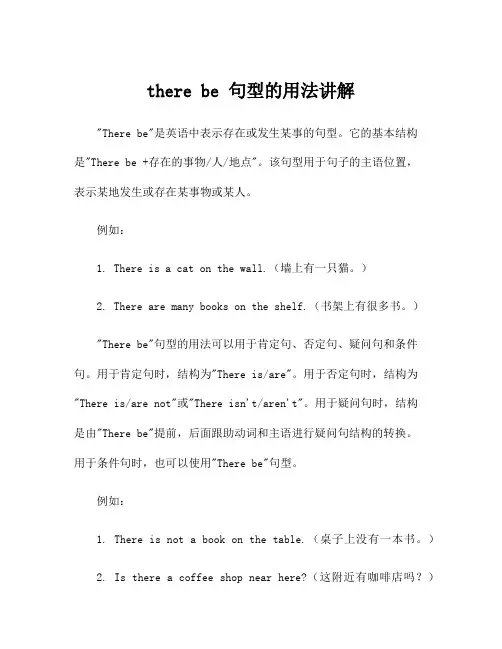
there be 句型的用法讲解"There be"是英语中表示存在或发生某事的句型。
它的基本结构是"There be +存在的事物/人/地点"。
该句型用于句子的主语位置,表示某地发生或存在某事物或某人。
例如:1. There is a cat on the wall.(墙上有一只猫。
)2. There are many books on the shelf.(书架上有很多书。
)"There be"句型的用法可以用于肯定句、否定句、疑问句和条件句。
用于肯定句时,结构为"There is/are"。
用于否定句时,结构为"There is/are not"或"There isn't/aren't"。
用于疑问句时,结构是由"There be"提前,后面跟助动词和主语进行疑问句结构的转换。
用于条件句时,也可以使用"There be"句型。
例如:1. There is not a book on the table.(桌子上没有一本书。
)2. Is there a coffee shop near here?(这附近有咖啡店吗?)3. If there is a problem, let me know.(如果有问题,请告诉我。
)除了基本的句型用法之外,可以在"There be"句型中加入修饰词和定语从句来进行拓展。
修饰词可以用来描述存在的物体的特征或数量,定语从句可以进一步描述关于存在的事物的信息。
例如:1. There is a big black dog in the backyard.(后院有一只又大又黑的狗。
)2. There are some students in the classroom who are studying.(教室里有一些正在学习的学生。
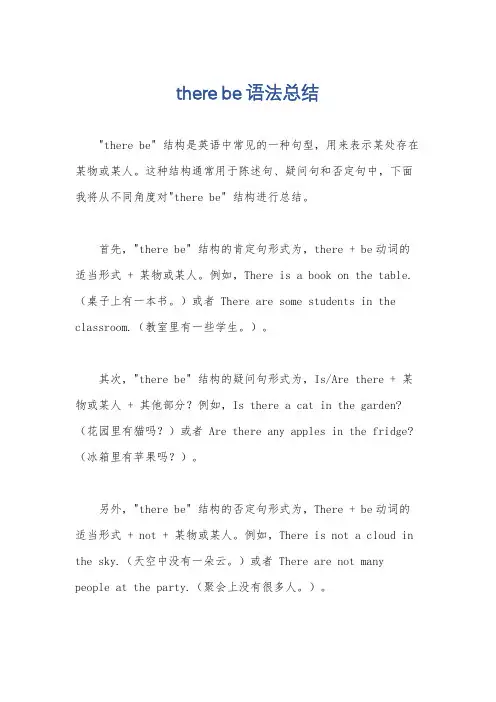
there be语法总结"there be" 结构是英语中常见的一种句型,用来表示某处存在某物或某人。
这种结构通常用于陈述句、疑问句和否定句中,下面我将从不同角度对"there be" 结构进行总结。
首先,"there be" 结构的肯定句形式为,there + be动词的适当形式 + 某物或某人。
例如,There is a book on the table.(桌子上有一本书。
)或者 There are some students in the classroom.(教室里有一些学生。
)。
其次,"there be" 结构的疑问句形式为,Is/Are there + 某物或某人 + 其他部分?例如,Is there a cat in the garden?(花园里有猫吗?)或者 Are there any apples in the fridge?(冰箱里有苹果吗?)。
另外,"there be" 结构的否定句形式为,There + be动词的适当形式 + not + 某物或某人。
例如,There is not a cloud in the sky.(天空中没有一朵云。
)或者 There are not many people at the party.(聚会上没有很多人。
)。
此外,"there be" 结构还可以用于各种时态,包括一般现在时、一般过去时、一般将来时等。
例如一般现在时,There is ameeting at 3 o'clock.(三点有个会议。
)一般过去时,Therewas a big tree in front of the house.(房子前有一棵大树。
)一般将来时,There will be a concert next week.(下周将有一场音乐会。
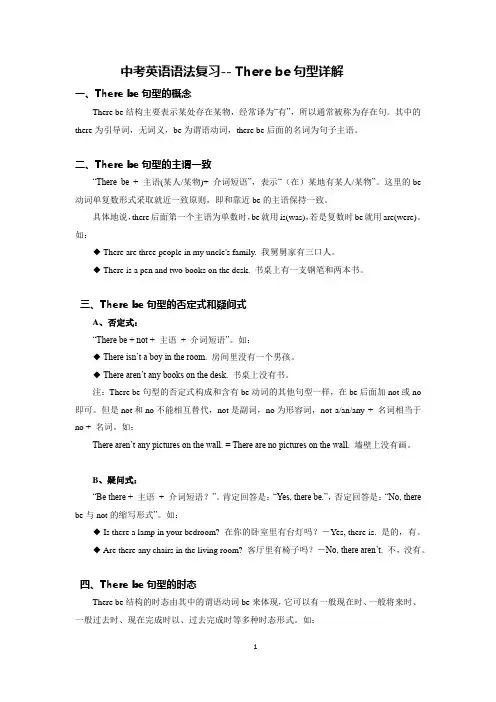
中考英语语法复习-- There be句型详解一、There be句型的概念There be结构主要表示某处存在某物,经常译为“有”,所以通常被称为存在句。
其中的there为引导词,无词义,be为谓语动词,there be后面的名词为句子主语。
二、There be句型的主谓一致“There be + 主语(某人/某物)+ 介词短语”,表示“(在)某地有某人/某物”。
这里的be 动词单复数形式采取就近一致原则,即和靠近be的主语保持一致。
具体地说,there后面第一个主语为单数时,be就用is(was),若是复数时be就用are(were)。
如:◆ There are three people in my uncle's family. 我舅舅家有三口人。
◆ There is a pen and two books on the desk. 书桌上有一支钢笔和两本书。
三、There be句型的否定式和疑问式A、否定式:“There be + not + 主语+ 介词短语”。
如:◆There isn’t a boy in the room. 房间里没有一个男孩。
◆There aren’t any books on the desk. 书桌上没有书。
注:There be句型的否定式构成和含有be动词的其他句型一样,在be后面加not或no 即可。
但是not和no不能相互替代,not是副词,no为形容词,not a/an/any + 名词相当于no + 名词。
如:There aren’t any pictures on the wall. = There are no pictures on the wall. 墙壁上没有画。
B、疑问式:“Be there +主语+ 介词短语?”。
肯定回答是:“Yes, there be.”,否定回答是:“No, there be与not的缩写形式”。
如:◆ Is there a lamp in your bedroom? 在你的卧室里有台灯吗?-Yes, there is. 是的,有。
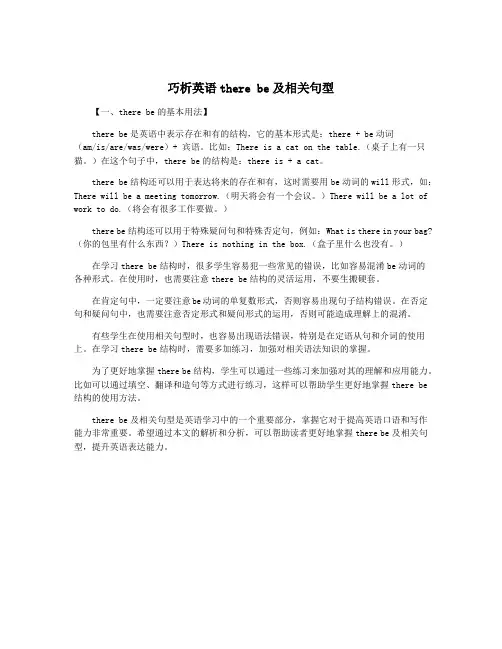
巧析英语there be及相关句型【一、there be的基本用法】there be是英语中表示存在和有的结构,它的基本形式是:there + be动词(am/is/are/was/were)+ 宾语。
比如:There is a cat on the table.(桌子上有一只猫。
)在这个句子中,there be的结构是:there is + a cat。
there be结构还可以用于表达将来的存在和有,这时需要用be动词的will形式,如:There will be a meeting tomorrow.(明天将会有一个会议。
)There will be a lot of work to do.(将会有很多工作要做。
)there be结构还可以用于特殊疑问句和特殊否定句,例如:What is there in your bag?(你的包里有什么东西?)There is nothing in the box.(盒子里什么也没有。
)在学习there be结构时,很多学生容易犯一些常见的错误,比如容易混淆be动词的各种形式。
在使用时,也需要注意there be结构的灵活运用,不要生搬硬套。
在肯定句中,一定要注意be动词的单复数形式,否则容易出现句子结构错误。
在否定句和疑问句中,也需要注意否定形式和疑问形式的运用,否则可能造成理解上的混淆。
有些学生在使用相关句型时,也容易出现语法错误,特别是在定语从句和介词的使用上。
在学习there be结构时,需要多加练习,加强对相关语法知识的掌握。
为了更好地掌握there be结构,学生可以通过一些练习来加强对其的理解和应用能力。
比如可以通过填空、翻译和造句等方式进行练习,这样可以帮助学生更好地掌握there be 结构的使用方法。
there be及相关句型是英语学习中的一个重要部分,掌握它对于提高英语口语和写作能力非常重要。
希望通过本文的解析和分析,可以帮助读者更好地掌握there be及相关句型,提升英语表达能力。
五年级语法-ThereBe句型五年级语法- There Be 句型牛津英语5A.语法There Be 结构“There Be…”的结构表示“存在”的一个特殊句型。
该句型在使用时必须注意以下几点1 “There be…”结构表示“某时,某地存在着什么事物或人”这个句子结构中there本身没有词义,be是谓语动词,be动词后面的是主语,这两者的数必须一致。
句子的最后是地点或时间状语。
例如:There is a book on the desk. 主语是a book 单数因此谓语动词用is on the desk在课桌上就是地点状语。
这几句的意思就是“在课桌上有一本书。
”2 “There be…”结构的谓语动词be在人称和数上应与其后的主语保持一致。
(也就是主语是不可数名词或可数名词的单数形式,谓语动词用is,主语是复数,谓语动词用are)如:There is some water in the bottle.一些水(不可数名词)There is a pencil box in my schoolbag.一个铅笔盒(可数名词的单数形式)There are some books on my chair.一些书(可数名词的复数形式)3 若句子中有几个并列主语,be的形式要与力气最近的一个主语在人称和数的形式上保持一致,也就是“就近原则”如:There is a river, a small house and some green trees in the picture.There are some trees, a river and a small house in the picture.本学期1-2单元语法重点(5A)There Be 结构的句型转换1 如何转换成否定句“There be… ”句型的否定式通常在be动词后加上not即可。
(be动词通常会与not缩写在一起is not写成isn’t,are not写成aren’t,如果句中有some ,改为否定句时要把some变为any。
therebe句型简介在英语语法中,therebe句型是用于表达存在或存在特定事物的句型。
该句型由there和be动词构成,用于描述某地点或某情况下存在某人、某物或某事物。
用法therebe句型的一般结构是:there + be动词 + 存在的人、物或事物。
例如: - There is a cat in the garden.(花园里有一只猫。
) - There are some books on the shelf.(书架上有一些书。
)在使用therebe句型时,要注意以下几个要点:1. 代词和冠词的使用•在句子中,当主语是可数名词的复数形式时,使用are作为be动词的形式。
例如:There are some cars on the street.(街道上有一些车。
)•当主语是不可数名词或单数名词时,使用is作为be动词的形式。
例如:There is a book on the table.(桌子上有一本书。
)2. 一般疑问句和否定句的构成•一般疑问句的构成是将be动词调到句首,并在句尾加问号。
例如:Is there a cat in the garden?(花园里有一只猫吗?)•否定句的构成是在be动词后加上not。
例如:There is not a book on the table.(桌子上没有书。
)3. 描述特定位置或情况•therebe句型的目的是描述特定的位置或情况下存在的人、物或事物。
例如:There is a park near my house.(我的房子附近有一个公园。
)这里的。
小学英语语法专题:There be句型用法详解及练习{ There be句型}语法专题详解There be 句型的用法:表示某个地方存在某物或某人,Be动词的单复数必须依主语的变化而变化。
(单数is 复数are )eg:There is a table in the room. 房间里有一张桌子。
There are some birds on the tree.树上有很多鸟。
一、There be 句型的结构:1.常见句型结构(一)There is+单数可数+地点状语eg:There is a ruler on the desk. 书桌上有一把尺。
(二)There are+复数主语+地点状语eg:There are four apples on the tree. 树上有四个苹果。
There are some flowers in the park. 公园里有许多花。
(三)there is + 不可数名词+地点状语(即使有some 也是单数)eg:There is some water in the bottle. 瓶子里有一些水。
(水是不可数名词)2. There be选择就近原则:There be句型的就近原则是There be句型中语法项目的重点考点。
There be句型中be动词的单复数形式由最挨近的一项的单复数决定。
如:There is a pen, two books and many pencils on the desk.(在本句中尽管有钢笔、书和铅笔,但是由于离be动词最近的一项是单数a pen,因此,be动词用单数is。
)二、There be 句型的疑问句及回答(一)There be 句型的疑问1. 在“There is/are...”的疑问句中,要把Be动词放在there之前,并将句号变问号。
难点:句中出现的some要改成any。
2. 肯定回答为:Yes, there is/are.3. 否定回答为: No, there isn’t/aren’t.eg: 可数名词单数1. 肯定句There is an apple on the tree.疑问句Is there an apple on the tree?肯定回答: Yes, there is. 否定回答: No, there isn’t.可数名词复数2. 肯定句There are five pens on the desk.疑问句Are there five pens on the desk?肯定回答: Yes, there are. 否定回答No, there aren’t.不可数名词的时候3.肯定句There is some water in the cup. (水是不可数名词)否定句Is there any water in the cup?肯定回答: Yes, there is. 否定回答: No, there isn’t.(二)There be 句型的特殊疑问句:There be句型的特殊疑问句形式有以下三种变化:①对主语提问:当主语是人时,用\"Who\'s+介词短语?\";当主语是物时,用\"What\'s + 介词短语?\"。
There be 句型1. 定义:There be句型表示某处存在某物或某人。
2. 结构:(1) There is +单数可数名词/不可数名词+ 地点状语.(2) There are +复数名词+地点状语.there是引导词,在句中不充当任何成分,翻译时也不必译出。
句子的主语是某人或某物,谓语动词be要与主语(某人或某物)的数保持一致。
当主语是两个或两个以上的名词时,谓语动词要与跟它最近的那个名词一致。
①There is a bird in the tree. 树上有一只鸟。
②There is a teacher and many students in our classroom. 我们教室里有一位老师和许多学生。
③There are two boys and a girl under the tree. 树下有两个男孩,一个女孩。
3. There be句型与have的区别:(1) There be 句型和have都表示“有”的含义。
区别如下:There be表示“某处存在某物或某人”,强调存在关系;have表示“某人拥有某物/某人”,强调所有、拥有关系。
There be结构一般用在句子的开头,而have(has)等词只能用于某一个主语后面。
eg.①He has two sons. 他有两个儿子。
②There are two men in the office. 办公室里有两个男人。
(2) 当have表示“包括”、“存在”的含义时,There be 句型与其可互换。
e.g. A week has seven days. =There are seven days in a week. 一个星期有七天。
4. There be句型的时态There be可以有现在时(there is/are)、过去时(there was/were)、将来时(there is/are going to be或there will be);5. There be句型的句式变脸一:否定句There be句型的否定式的构成和含有be动词的其它句型一样,在be后加上not 或no即可。
专题13 There be 句型一、there be句型的概念There be句型表示“在某地存在某物(某人) ”。
二、there be句型的结构1. 肯定句:There is/are+主语+地点。
如:There is (be) a pen on the desk. 桌子上有一支钢笔。
There are(be) some sheep on the hill. 山上有一些羊。
2. 否定句:There is/are+not +主语+地点。
如:There aren’t any apples on the desk. 桌子上没有苹果。
3. 一般疑问句:Is/Are +there +主语+地点?肯定回答:Yes, there is/are.否定回答:No, there+ isn’t/aren’t.如:例:There are some sheep on the hill. 山上有一些绵羊。
(改为一般疑问句并作回答)—Are there any sheep on the hill? 在山上有一些绵羊吗?—Yes, there are. 是的,有。
—No, there aren’t.不,没有。
三、there be 句型的就近原则There be句型中的主语为并列二个或二个以上的名词时,be动词的形式与最接近它的第一个名词的数保持一致(即:就近原则)。
如:There is a bed, a desk and two chairs in my bedroom.在我的房间里面有一张床、一张桌子和两张椅子。
There are two chairs, a bed and a desk in my bedroom.在我的房间里面有两张椅子、一张床和一张桌子。
四、there be 句型与have/has的区别There be 和have/has 都可以表示“有”的意思,但have/has表示的是“所属”的“有”,可翻译为“某人拥有某物”,而there be结构则表示的是“某地存在有某物(某人) 。
学外语的十条经验1、学习外语一天也不能中断。
倘若确实没有时间,哪怕每天挤出10分钟也行;早晨是学习外语的大好时光。
2、要是学厌了,不必过于勉强,但也不要扔下不学。
这时可以改变一下学习方式;比如把书放到一边去听听广播,或暂时搁下课本的练习去翻翻词典等。
3、绝不要脱离上下文孤立地去死背硬记。
4、应该随时地记下并背熟那些平日用得最多的“句套子”。
5、尽可能‘心译’你接触到的东西,如一闪而过的广告,偶而听到的话语,这也是一种休息的方式。
6、只有经过教师修改的东西才值得牢记。
不要反复去看那些做了而未经别人修改的练习,看多了就会不自觉地连同错误的东西一起记在脑了里。
假如你纯属自学而无旁人相助,那你就去记那些肯定是正确无误的东西。
7、抄录和记忆句子和惯用语时要用单数第一人称,如“I am only pulling your leg"(我只是要戏弄你)8、外语好比碉堡,必须同时从四面八方向它围攻:读报纸,听广播,看原文电影,听外语讲演,攻读课本,和外国朋友通讯,来往,交谈等等。
9、要敢于说话,不要怕出错误,要请别人纠正错误。
尤为重要的当别人确实为你纠正错误时,不要难为情,不要泄气。
10、要坚信你一定能达到目的,要坚信自己有坚强不屈的毅力和语言方面的非凡才能……What is in the classroomHow many students are there in the classroom Where are 5 studentsThere are not 5 students in the classroom. Are there 5 students in the classroomYes, there are. No, there aren’t.Are you from Jinhua or NingboThere are not 5 students in the classroom, aren’t thereHe is a teacher, isn’t heThere be 结构用法There be 句型归纳与练习There be 句型1. 定义:There be句型表示某处存在某物或某人。
2. 结构:(1) There is +单数可数名词/不可数名词+ 地点状语.There is an apple on the table.There is some water in the bottle.(2) There are +复数名词+地点状语.There are 2 books in my bag.there是引导词,在句中不充当任何成分,翻译时也不必译出。
句子的主语是某人或某物,谓语动词be要与主语(某人或某物)的数保持一致。
当主语是两个或两个以上的名词时,谓语动词要与跟它最近的那个名词一致---就近原则。
eg. ① There is a bird in the tree.树上有一只鸟。
② There is a teacher and many students in our classroom.我们教室里有一位老师和许多学生。
③ There are two boys and a girl under the tree. 树下有两个男孩,一个女孩。
3. There be句型与have的区别:(1) There be 句型和have都表示“有”的含义。
区别如下:There be表示“某处存在某物或某人”;have表示“某人拥有某物/某人”,它表示所有、拥有关系。
eg.①He has two sons.他有两个儿子。
②There are two men in the office.办公室里有两个男人。
(2)当have表示“包括”、“存在”的含义时,There be 句型与其可互换。
eg. A week has seven days. =There are seven days in a week. 一个星期有七天。
一、否定句There be句型的否定式的构成和含有be动词的其它句型一样,在be后加上not即可。
注意not是副词例如:There are some pictures on the wall. →There are n't any pictures on the wall. =There are no pictures on the wall. There is a bike behind the tree. → There isn't a bike behind the tree. =There is no bike behind the tree.二、一般疑问句There be句型的一般疑问句变化是把be动词调整到句首,再在句尾加上问号即可,此为\"调整法\"。
但同时要注意:当肯定句中有some时,要将其改为any(否定变化也一样)。
看看下面两句是如何改变的:There is some water on Mars. → Is there any water on Mars There are some fish in the water. →Are there any fish in the water三、特殊疑问句There be句型的特殊疑问句形式有以下三种变化:① 对主语提问:当主语是人时,用"Who's+介词短语 ";当主语是物时,用"What's + 介词短语"。
注意:无论原句的主语是单数还是复数,对之提问时一般都用be的单数形式(回答时却要根据实际情况来决定)。
如:There are many things over there. →What's over there There is a little girl in the room. →Who is in the room ② 对地点状语提问:提问地点用 "Where is / are+主语"例如:There is a computer on the desk. → Where is the computer There are four children on the playground. →Where are the four children③ 对数量提问:一般有两种句型结构:How many+复数名词+are there+介词短语How many books are there on the desk?How much+不可数名词+is there+介词短语How much money is there in your pocketThere be 结构在英语中是一个常见的句子结构,组成为“引导词there +be+主语+状语”。
句子的特殊用法较多,下面就there be 结构归纳如下:1. There和live, lie, come, stand, exit, remain, happen, enter等表示存在、状态的动词连用。
例:There once lived an old fisherman in a village by the sea.There stands a big tree on the top of the mountain. There happened an event.There came shouts for help from that river.There lies a large tree in front of our office. 2.There和情态动词连用,使存在的状态更加具体化、形象化,描述的语气多样化。
例: There may be 3500 students in our school.There must be some mistakes.There ought to be no trouble.There used to be a temple here.3. There和seem to be, appear to be, happen to be, be bound to be, be likely to be等连接,表示“碰巧有”、“可能有”、“一定有”。
例:There happened to be an old friend of mine in the factory.There seems to be something wrong with it.4. There be+名词,它的后面可以接状语、定语从句、不定式结构或ing分词和ed分词结构。
例:There are many reasons for animals dying out.There will be an English party in our school this evening.There are always new things to be discovered.There were many people in the street watching the film.注:如有两个或两个以上并列主语时,be常与最靠近的主语在人称和数上一致。
例:There is only a table, four chairs and a small bed in the room.is 和there be 结构比较:it is和there be 句型的区别要通过具体的环境来看,有时意义相同,有时含义差距较大。
例:It is windy today.=There is a wind toady.(It is+形容词,there be+名词)It is a long way from Beijing to Shanghai.从北京到上海路程很远。
There is still a long way to go.还有很长的路要走。
There is someone at the door. I think it is the man to deliver the papers.There is no doubt that he is not at home now.毫无疑问他现在不在家。
There be 句型练习一.根据所给汉语完成句子。
1. 桌子上有一本书和两支钢笔。
There _____ a book and two pens on the desk.2. 钱包里有些钱。
There ____ some money in the wallet.3. 在吉姆的书包里有一些卡片。
____ _____ some cards in Jim’s bag.4. 里面还有其他的东西吗_____ _____ anything else in it?5. 我们学校有许多班。